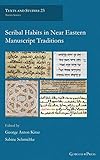Scribal Habits in Near Eastern Manuscript Traditions / ed. by George Kiraz, Sabine Schmidtke.
Material type: TextSeries: Texts and Studies (Third Series) ; 23Publisher: Piscataway, NJ : Gorgias Press, [2021]Copyright date: ©2021Description: 1 online resource (320 p.)Content type:
TextSeries: Texts and Studies (Third Series) ; 23Publisher: Piscataway, NJ : Gorgias Press, [2021]Copyright date: ©2021Description: 1 online resource (320 p.)Content type: - 9781463241957
- 9781463241964
- Manuscripts -- Middle East -- Editing
- Marginalia -- Middle East -- History
- Middle Eastern literature -- Criticism, Textual
- Paratext -- Middle East -- History
- Scribes -- Middle East -- History
- Transmission of texts -- Middle East -- History
- Ancient Languages
- FOREIGN LANGUAGE STUDY
- General
- FOREIGN LANGUAGE STUDY / Ancient Languages (see also Latin)
- 002.0956 23
- Z242.P37
- online - DeGruyter
| Item type | Current library | Call number | URL | Status | Notes | Barcode | |
|---|---|---|---|---|---|---|---|
 eBook
eBook
|
Biblioteca "Angelicum" Pont. Univ. S.Tommaso d'Aquino Nuvola online | online - DeGruyter (Browse shelf(Opens below)) | Online access | Not for loan (Accesso limitato) | Accesso per gli utenti autorizzati / Access for authorized users | (dgr)9781463241964 |
Frontmatter -- TABLE OF CONTENTS -- CONTRIBUTORS -- PREFACE -- CONNECTING THE DOTS: USING DIAERESIS AS A SOURCE OF INFORMATION ABOUT SCRIBAL PRACTICES IN BYZANTINE EGYPT -- MARGINALIA AS TRACES OF CHANGING KNOWLEDGE CULTURE: THE CIRCULATION OF TAQWĪM TEXTS IN THE LATE MAMLUK SULTANATE -- THE MANUSCRIPTS OF ARABIC POPULAR SIYAR AND SĪRAT SAYF IBN DHĪ YAZAN -- A PORTABLE MAJLIS: ON PUBLISHING RELIABLE EDITIONS IN OTTOMAN MANUSCRIPT CULTURE -- CHAPTER DIVISIONS AND THE INTERPRETATION AND TRANSMISSION OF THE TOSEFTA -- THE SECOND-HAND SCRIBE: THE INTELLECTUAL ENVIRONMENT OF THE PRODUCTION OF A UNIQUE TOSEFTA FRAGMENT FROM THE LEVANT -- PERITEXTUAL ENCODING FOR THE METATRON / YAHOEL THEME IN THE KABBALISTIC SEFER HA-OT , OR “BOOK OF THE SIGN,” BY R. ABRAHAM ABULAFIA (1240–1292) -- READING AND REMEMBERING IN THE MEDIEVAL NEAR EAST: THE SYRIAC SHEMOHĒ BOOK (AKA. THE SYRIAC “MASORAH”) -- ANNOTATIONS IN THE EARLIEST MEDIEVAL HEBREW BIBLE MANUSCRIPTS -- AN ILLUMINATING SCRIBE: THE ʿARZADASHT OF JAʿFAR BĀYSUNGHURĪ AND ITS WEALTH OF INFORMATION -- ANNOTATION PRACTICES IN A SYRIAC EXEGETICAL COLLECTION (MS VAT. SYR. 103) -- SCRIBES AND THE BOOK OF REVELATION IN EASTERN NEW TESTAMENTS -- ON THE SUMERIAN GLOSSOGRAPHIC TRADITION -- CAN MANUSCRIPT HEADINGS PROVE THAT THERE WERE ARABIC GOSPELS BEFORE THE QURʾĀN?
restricted access online access with authorization star
http://purl.org/coar/access_right/c_16ec
Most scholars who employ manuscripts in their research tend to focus on the literary content itself. But what about the role of the scribe who typically remains at the periphery of research? How can we, in the words of the NT textual critic James Royse, “virtually look over the scribe’s shoulder” to understand the process by which our manuscripts were produced? Moreover, manuscripts often contain far more material than the words that form their primary texts: dots and various other symbols that mark vowels (in the case of Semitic languages), intonation, readings aids, and other textual markers; marginal notes and sigla that provide additional explanatory content akin to but substantially different from our modern notes and endnotes; images and illustrations that present additional material not found in the main text. These extratextual (or peritextual) elements add additional layers to the main body of the text and are crucial for our understanding of the text’s transmission history as well as scribal habits. This volume brings together contributions by scholars focussing on such extra-, peritextual elements as found in Middle Eastern manuscripts written in Hebrew, Syriac, Arabic, Persian and other languages, to study the individuals who produced our manuscripts and how they shaped the transmission of literary texts they copied.
Mode of access: Internet via World Wide Web.
In English.
Description based on online resource; title from PDF title page (publisher's Web site, viewed 25. Jun 2024)


